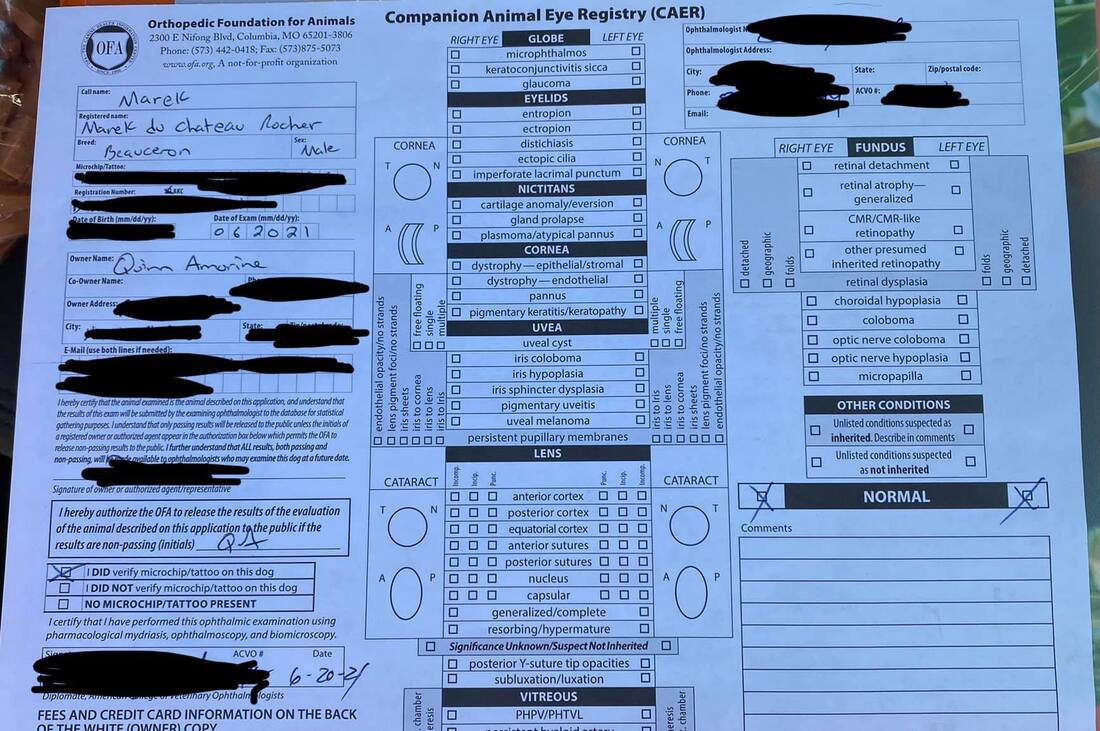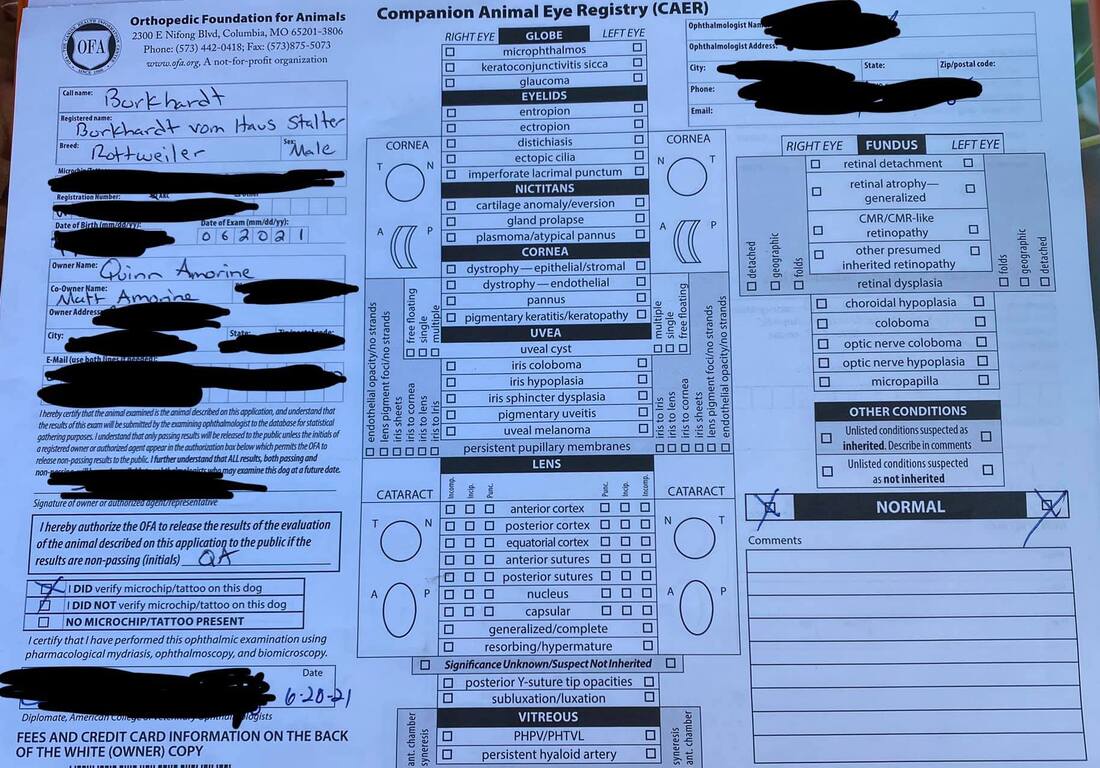|
Both Rottweilers and Beaucerons need to have their eyes checked yearly and updated with the Orthopedic Foundation for Animals in order to stay current on their health testing for breeding. Today Burkhardt and Marek got their yearly test done and both passed!
0 Comments
 I am frequently asked for help in finding a responsible breeder and I am always more than happy to help point people in the right direction but I thought I'd do a series of posts sharing what kind of information I look into when researching a breeder to recommend. I want to give a brief definition of the different ways to get a puppy. The first is from a responsible breeder who health tests their dogs and is working to preserve the breed they are focused on. Second is from a rescue organization or shelter. And third is from a breeder often referred to a backyard breeder. These breeders usually do little to no health testing and generally aren't breeding to better the breed. Most are people who just own two dogs they bred together or use a random dog to breed to theirs without much evaluation going into the pairing. There are also puppy mills which are mass producing breeders that generally have many breeds on their property and constantly have puppies. Puppy mills don't do any health testing at all generally and most their dogs are just there to have puppies. This post is going to talk about how to recognize a responsible breeder however if you don't want to purchase from a breeder I highly recommend looking into a reputable rescue organization as the other option. It can be hard to spot the difference between a backyard breeder and a responsible breeder and some of the less reputable breeders can be rather convincing that they are doing everything right. It's important to note that purebred does not always mean well bred. A dog can be a purebred dog from a breeder who appears responsible and is AKC registered with a pedigree and still be poorly bred. That's where research and knowing what to look for is hugely important when picking a breeder. Responsible breeding is generally categorized by health testing all dogs in the breeding program, focusing on correct temperament for the individual breed (yes every breed has its own temperament. Not all dogs are alike so you can't get a terrier if you want it to act like a Labrador but choosing a breed is a topic for another day), breeding dogs with sound physical structure so they don't break down as they age and breeding to the breeds written standard. Much of this is proven by breeders through working their dogs in what their breed was originally created for or through the various sports and jobs offered for dogs. Health Testing This post is going to cover health testing and how to verify that your chosen breeder is doing everything they should to try and produce healthy puppies. Health is never a 100% guarantee and things can still go wrong but fully health testing stacks the odds in your puppies favor that they will have a healthier life. Health can affect so much of a dogs daily living. A dog in pain can change their personality drastically and can cause them to live a less fulfilled life if they aren't able to use their bodies the way they should be able to. Every breed has health issues that can affect them. Some breeds more than others. Mixed breeds are also affected by genetic diseases so if you are buying a purpose bred mix know that breeding two dogs together doesn't cancel out health issues that purebreds are susceptible to. In fact it means that the mixed breed dog could be at risk of developing health issues from any of the breeds within them and any breeder breeding a mixed breed should be testing for any health issues that can pop up in all breeds they are breeding together (if you are getting a poodle and golden retriever mix sometimes called a Golden Doodle the breeder should be doing all the Golden Retriever health testing and the Poodle health testing on all of their mixed bred dogs for example). Most genetic diseases cannot be detected at normal vet checkups. The health testing breeders should be doing before breeding has to be done by specialists. Each breed has different health tests that are recommended by their individual breed clubs. These breed clubs are made up of longtime breeders, owners and enthusiasts to their breeds and they help preserve the breed and ensure it's future. In the United States we have the Orthopedic Foundation for Animals (OFA) that helps with education on canine health and they also offer an open online database of all dogs that have been health tested and recorded through them. This is a common place for breeders to record their dogs health testing. Not all breeds use OFA but a large majority of them do. If the breeder imports dogs from out of the country then their health testing records may be different but for most breeders in the United States, OFA is where you should be able to verify that they health test their dogs. If a breeder is not listing their dogs on OFA that would be something of a red flag and would need to be further looked into on why. To find out what OFA recommends for the breed you are looking into click here and click on the breed you are interested in. As an example, OFA recommends these tests for Rottweilers: This means Rottweilers should have their hips and elbows x-rayed by a orthopedic veterinarian that has experience in taking correct images for OFA. They should have their eyes examined by a Ophthalmologist. They should have their heart evaluated by a Cardiologist. These four tests are the bare minimum that should be done by a Rottweiler breeder before breeding. However the American Rottweiler breed club also recommends that they test for JLPP which is a horrible disease that puppies usually only survive for a short time from. Other genetic testing recommended for Rottweilers includes Degenerative myelopathy (DM), Leukoencephalomyelopathy (LEMP), Neuroaxonal dystrophy (NAD), Polyneuropathy with ocular abnormalities and neuronal vacuolation (POANV), and X-linked myotubular myopathy (XLMTM). These tests are done using a mouth swab and sent away to a lab. Some of these are done through big companies such as Embark or Wisdom Panel but some can be done through veterinarian labs such as UC Davis. You can see in the image above the the American Rottweiler Club (ARC) also requires at least one parent to be clear of JLPP before being bred. Each breeds parent club may have recommendations that aren't listed in OFA. To find your breeds parent club click here and scroll to find your breed. The parent club for each breed is a great resource for information about your chosen breed and can also be useful in finding out more information on locating an ethical breeder. Once you've looked up what tests OFA recommends for your breed and you've found a breeder that claims to do all recommended health testing, you can verify this yourself. It's important to make sure the testing is actually being done as some of the less reputable breeders think vet checkups is the same as health testing and will answer that their dogs are health tested when they really aren't. Some also only do DNA testing such as Embark and ignore some of the bigger health issues that need to be tested for in the hope that the DNA test is enough to satisfy someone from looking any further. If you head over to the OFA website by clicking here they have a "look up health tested dogs" at the top where you can search for specific dogs. Your potential breeder should provide registered names for their dogs (they may show you the dogs pedigrees of their upcoming breeding as well which would list registered names) or you can find them on the breeders website if they have one. Reputable breeders register their dogs through organizations such as American Kennel Club (AKC) as a way to keep records on their dogs and prove they are purebred. They must also be registered to compete in events that help evaluate their dogs for breeding such as conformation showing. Other reputable clubs to register through is the United Kennel Club (UKC) and some may be registered in Canada with the Canadian Kennel Club (CKC). You want to stay clear of registries such as the Continental Kennel Club and the United All Breed Dog Registry. American kennel club, United kennel club and Canadian kennel club all have strict registration rules that other organizations don't follow as closely. Once you have the registered names of the potential parents to your puppy or any of the breeders dogs, put one into the search box on the top of the OFA website. It will show you any dogs registered with that name or similar names. Click on the dogs name you are looking for and it should take you to that dogs individual page listing all its health testing results along with all relatives that have been tested so you will be able to see that dogs parents, siblings, grandparents, etc.. and how they did on their test results. It's important to make sure you have the name correct as some dogs may have similar registration names with only a single word difference. Breeders have a kennel name and often times the only difference in a registered name is the kennel name. So there may be a Labrador Retriever with the registered name "Sunshine's All That Glitters". Sunshine is the breeders kennel name and then there may be a German Shepherd with the registered name "Apollo's All That Glitters" and again Apollo is the kennel name. It will show you the dogs breed next to their name and when you do click on the dogs name you are looking for, the top of their individual page will also show their breed and their birthday to help you make sure you have the correct dog. For example this is my Rottweiler, Burkhardt's personal OFA page (click to enlarge): Many health tests can be done at a year old or even younger such as eyes and DNA swabs but some need to wait until the dog is 2 years such as hips and elbows. Some breeders will just wait and do most testing at the same time at 2 years old. If a dog is under the age of 2 and has hips and elbows listed fully on OFA that is something to question. If a dog has been bred before 2 years old and its breed that should have hips done then it was bred before completing that health test which is a red flag.
In the image above it shows under "registry" the various health issues we are testing for such as eyes, hips, elbows, ect.... then it shows the date it was tested and the date OFA recorded it after the paperwork from the vet that preformed the test was sent in to them. It shows the age he was at the time of testing and the "final conclusion" which is his passing or failing scores essentially. Most health tests are straight forward. The health condition is either listed as normal or abnormal or a carrier or normal (clear). However some get a rating. Hips are rated for example so ideally any dog being bred would have a rating of Excellent, Good or Fair. If all health testing that OFA recommends is completed on a specific dog they are issued a CHIC number that a breeder may give you to show it is all completed. However that number just says the dog has been fully tested. It does not tell you if the dog has passed those tests so you should still verify that the dog has passing ratings. Make sure you talk to any breeder you are interested in about the health testing they are doing and be an educated buyer on what health tests are necessary for your breed and become familiar about how to check that your potential puppies parents have been health tested so you don't end up with a genetic surprise as they grow up. It may seem like a lot of work to dig into all the health testing a breed should have done but this is a crucial part of knowing more about your puppies health. Breeders who fully health test are providing you with a history of health in your puppies pedigree. It also shows they care about the breeds future and the health of the dogs they are producing and living with. The next post I'll cover how breeders evaluate their dogs temperaments and structure and why that's an important piece of responsible breeding. |
BlogWelcome to Cavall's blog! Archives
October 2023
Categories |





 RSS Feed
RSS Feed